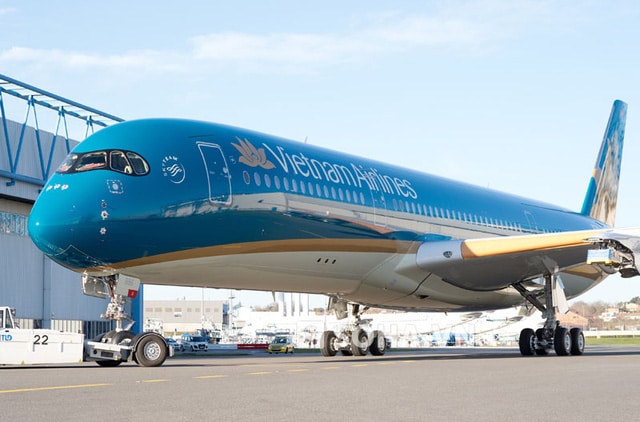Aerospace
Vietnam Airlines signs MOU for 10 more A350 XWBs

Carrier to operate world’s newest widebody on non-stop services to US
Vietnam Airlines has signed a Memorandum of Understanding (MOU) with Airbus for 10 more A350-900 aircraft. The aircraft will be used by the airline on non-stop flights to the US, beginning with services between Ho Chi Minh City and Los Angeles.
The MOU was signed in Hanoi today by Duong Tri Thanh, President and CEO of Vietnam Airlines, and Fabrice Brégier, Airbus President & CEO. The signing took place during the state visit to Vietnam of François Hollande, President of France, and was witnessed by Mr Hollande and Tran Dai Quang, President of the Socialist Republic of Vietnam.
Vietnam Airlines last year became the first airline in East Asia and the second in the world to operate the A350 XWB. The carrier already has four aircraft in service, with another 10 on firm order for future delivery. The additional 10 aircraft covered by today’s MOU will enable Vietnam Airlines to operate non-stop to the US West Coast, carrying 305 passengers in a three class premium layout.
“The intention to acquire these additional aircraft reflects our excellent experience with the A350 since it entered service with Vietnam Airlines last year,” said Duong Tri Thanh, President and CEO of Vietnam Airlines. “With its very long range capability, economic fuel consumption and spacious cabin, the A350 is the suitable aircraft for our proposed intercontinental routes to Europe and the US. The start of non-stop transpacific services with the A350 is yet another example of the commitment we have at Vietnam Airlines to strengthen our position as one of the world’s leading international carriers.”
“Today’s agreement further consolidates the A350’s position as the new long haul leader in the mid-size widebody category,” said Fabrice Brégier, Airbus President and CEO. “The A350 XWB has quite simply set new standards in its class, combining unbeatable operating economics with the highest levels of passenger comfort. We look forward to working closely with Vietnam Airlines as it continues to develop its long haul network and strengthens its position in the premium market.”
The all-new A350 XWB features the latest aerodynamic design, carbon fibre fuselage and wings, plus fuel-efficient Rolls-Royce Trent XWB engines. Together, these latest technologies translate into unrivalled levels of operational efficiency, with a 25 per cent reduction in fuel burn and emissions, and significantly lower maintenance costs. For passengers, the A350 XWB sets new standard in terms of in-flight comfort, with an extra-wide cabin offering more personal space in all classes, including 18 inch wide seats as standard in economy class.
To date, Airbus has recorded a total of 810 firm orders for the A350 XWB from 43 customers worldwide, already making it one of the most successful widebody aircraft ever. A total of 36 A350 XWBs have been delivered so far and the aircraft is now in service with eight carriers, including Vietnam Airlines.

Aerospace
Boeing Transfers Rocket Stage to NASA, Paving Way for Human Moon Mission

Boeing has achieved a significant milestone by providing NASA with the second core stage of the Space Launch System (SLS) rocket.
This crucial component, crafted at NASA’s Michoud Assembly Facility (MAF), is set to propel the Artemis II crew into lunar orbit, marking humanity’s return to deep space after a 50-year hiatus.
The monumental Boeing-built rocket stage, the largest element of the Artemis II mission, will embark on a journey aboard the Pegasus barge, traveling 900 miles to NASA’s Kennedy Space Center.
Comparison of two legendary aircraft B777x vs B747 aircraft:Click here
Upon arrival, it will be meticulously integrated with other essential Artemis II components, including the upper stage, solid rocket boosters, and NASA’s Orion spacecraft within the iconic Vehicle Assembly Building. This intricate integration process is a vital step toward the eagerly anticipated Artemis II launch, slated for 2025.
“Boeing-built products helped land humankind on the moon in 1969, and we’re proud to continue that legacy through the Artemis generation,” remarked Dave Dutcher, vice president and program manager for Boeing’s SLS program. “Together, with NASA and our industry partners and suppliers, we are building the world’s most capable rocket and paving the way to deep space through America’s rocket factory in New Orleans.”
NASA, Lockheed Martin Reveal X-59 Quiet Supersonic Aircraft:Click here
The delivery of Core Stage 2 marks a significant achievement in the evolution of the SLS rocket. Towering over 200 feet and powered by four RS-25 engines, this core stage, coupled with two solid-fueled booster rockets, will generate a staggering 8.8 million pounds of thrust. This immense power is crucial to launching Artemis II and future missions into the vast expanse of space.
The SLS rocket stands unparalleled in its capability to transport both crew and substantial cargo to the moon and beyond in a single launch. Its extraordinary capacity will facilitate the delivery of human-rated spacecraft, habitats, and scientific missions to destinations including the moon and Mars, ushering in a new era of space exploration.
-

 Travel1 week ago
Travel1 week agoAir India to Expand US Operations with Three New Routes After a Decade
-

 Travel2 weeks ago
Travel2 weeks agoWhy We Should Avoid These Stamps in a Passport
-

 Airlines1 month ago
Airlines1 month agoInvestigations Reveal Fake Chinese Titanium in Boeing and Airbus Jets
-

 Tech4 weeks ago
Tech4 weeks agoChina’s CATL Plans 1,800-Mile Electric Plane Launch by 2027
-

 Airport3 days ago
Airport3 days agoTop 10 Largest Airports in the World by Size
-

 Aerospace4 weeks ago
Aerospace4 weeks agoChina’s Fighter Jets Turn Wings into Autonomous Drones
-

 Airlines4 days ago
Airlines4 days agoAir India Rolls Out A350s for Delhi-New York JFK and Newark Routes
-

 Defence3 weeks ago
Defence3 weeks agoBoeing Enhances Chinook with New Engines and Block II Upgrades at $96 Million







